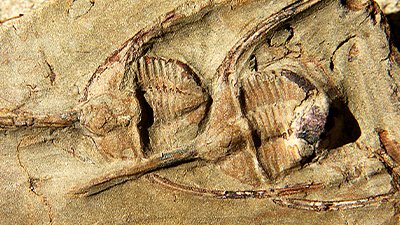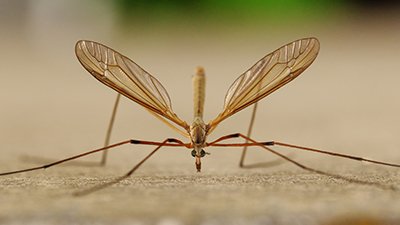
Saber-Toothed Squirrel Discovered Among Dinosaurs
Saber-toothed skulls surprise paleontologists.
News Source
A small extinct saber-toothed mammal dubbed Cronopio dentiacutus has paleontologists excited about the features it combines. The two partial skulls and jaws, recently freed from their stony tomb of Cretaceous rock, were found in Argentina in 2002 in rock layers dated 100 million years old by evolutionary reckoning. The mammalian skulls, only about 27 mm long,1 came from La Buitrera where dinosaurs and a variety of other fossilized vertebrates are found. They are said to be the second oldest mammalian skulls yet found in South America,2 “bridging a previous 60-million-year gap in the fossil record.”3
“During the age of the dinosaurs, no mammal was bigger than a mouse,” says author Sebastian Apesteguia. (There is apparent hyperbole here, since evolutionary catalogues of mammals do include many examples of dinosaur-age mammals larger than mice, though many are on the small side.) Evolutionary paleontologists believe these small mammals were early in their evolutionary history.
Fossilized mammals in the same layers as the dinosaurs are rare finds, according to these researchers.
Fossilized mammals in the same layers as the dinosaurs are rare finds, according to these researchers. Therefore, they believe the fossil record for early mammalian history is “woefully incomplete.”4 “Imagine trying to reconstruct the history of life with that information,” lead author Guillermo Rougier says. “We’re certain there were hundreds of [genuses], but for now it's like trying to reconstruct the brilliance of James Joyce with just ten of his words.”5 The authors add, “Such discoveries of remarkably complete Mesozoic fossils always represent giant steps” in the study of mammalian evolution. “In fact, one reasonably preserved Mesozoic mammalian skull in a critical stratigraphic and geographic position can be more relevant to our understanding of mammalian evolution and biogeography than hundreds of isolated teeth.”
The saber-toothed Cronopio is not a squirrel but an extinct mammal called a dryolestoid. Dryolestoid fossils are found all over the world. Up until now, however, dryolestoids have been known primarily by isolated jaws and teeth, so this chance to see a number of skull features together is a paleontologist’s dream.
Particularly surprising to the researchers was the combination of long fangs with ordinary molars typical of insectivores. These canines—the so-called saber-teeth—have been found in one other dryolestoid, but Cronopio’s are longer. Cronopio also had a long snout and big eyes, and it probably had to twist its jaw to chew its food “at the expense of a powerful bite.”6 “The back teeth, the molars, are the kind of teeth that you will find in an insectivore, an animal that eats insects of different kinds, and even very small invertebrates, or perhaps small lizards, which were present in the same place,” Rougier explains. “But we have no idea why he needed such huge canines. Those tusks are a big surprise.”7
The researchers say the creature probably resembled the character “Scrat” from the movie Ice Age. Rougier adds, “The comparison with Scrat [the animated movie creature] is superficial, but it just goes to show how diverse ancient mammals are, that we can just imagine some bizarre critter and later find something just like it.”
Dryolestoids are believed by evolutionists to belong to the “lineage leading to modern marsupials and placentals.”8 The researchers conclude, “Cronopio is an integral part of the evolutionary history leading to the South American mammalian communities of the Late Cretaceous. . . . Cronopio and other mammals yet to be described from La Buitrera locality are, because of their good preservation and relative completeness, our best hope to address the origin and early evolution of the Mesozoic mammalian faunas of South America.”
Cronopio, however, despite its presumed antiquity, fails its audition for the role of common mammalian ancestor. These Cronopio skulls show dryolestoids lacked the expected “skull morphology characterizing the hypothetical common ancestor of marsupials and placentals.”9 Instead, “Cronopio’s skull shows a combination of primitive mammalian features and highly specialized traits.”10
They see the geologic column as a timeline of evolutionary development rather than the order of burial in the global Flood.
The researchers’ interpretations and comments reveal their worldview-based opinions. They see the geologic column as a timeline of evolutionary development rather than the order of burial in the global Flood. Many evolutionists think the existence of small mammals in the same strata as dinosaurs proves mammals were early in their evolutionary history. And why would a primitive mammal necessarily be small? Actually, larger mammals are found in those “old” layers too. In fact, Nature in 2005 commented that such a view—that primitive mammals were “constrained from evolving diverse body types and sizes” until the dinosaurs were out of the way—is “outdated.”11
When a mammal with “highly-specialized” structures such as these saber-teeth appears in “older” layers, evolutionists scramble to determine when and why those features evolved. They are puzzled by the juxtaposition of “highly specialized” traits and “primitive” ones. In reality, these are not “primitive” characteristics or creatures, just those that happen to have been buried with the dinosaurs by the Flood.
Cronopio just happens to have some features in common with living insect-eaters, some features in common with other fossilized extinct creatures, and enough unique features to give its discoverers the prerogative of naming it as a new species. It is not a transitional form. The Bible tells us God created all the kinds of animals to reproduce after their kinds. These fossils have added to our knowledge of the dryolestoids as an extinct kind and revealed their diversity—diversity that happens to include some species with long canines. We would expect such diversity by the time of the Flood. But this discovery can tell us nothing about the evolution of mammals because God created the mammal kinds without evolution during Creation week about 6,000 years ago.
Further Reading
- Get Answers: The Flood
For More Information: Get Answers
Remember, if you see a news story that might merit some attention, let us know about it! (Note: if the story originates from the Associated Press, FOX News, MSNBC, the New York Times, or another major national media outlet, we will most likely have already heard about it.) And thanks to all of our readers who have submitted great news tips to us. If you didn’t catch all the latest News to Know, why not take a look to see what you’ve missed?
(Please note that links will take you directly to the source. Answers in Genesis is not responsible for content on the websites to which we refer. For more information, please see our Privacy Policy.)
Footnotes
- Guillermo W. Rougier, Sebastián Apesteguía, Leandro C. Gaetano, “Highly Specialized Mammalian Skulls from the Late Cretaceous of South America,” Nature 479, no. 7371 (November 3, 2011): 98–102 doi:10.1038/nature10591.
- Dave Mosher, “Ancient ‘Saber-toothed Squirrel’ Found,” National Geographic News, November 4, 2011, http://news.nationalgeographic.com/news/2011/10/101102-saber-toothed-squirrel-fossils-paleontology-dinosaurs-science/.
- Rougier, Apesteguía, and Gaetano, “Highly Specialized Mammalian Skulls from the Late Cretaceous of South America,” PubMed, http://www.ncbi.nlm.nih.gov/pubmed/22051679.
- Dave Mosher, “Ancient ‘Saber-toothed Squirrel’ Found.”
- Ibid.
- Guillermo W. Rougier, Sebastián Apesteguía, Leandro C. Gaetano, “Highly Specialized Mammalian Skulls from the Late Cretaceous of South America.”
- Jonathan Amos, “Tiny but Toothy Mammal Unearthed,” BBC News, November 2, 2011, http://www.bbc.co.uk/news/science-environment-15540455.
- Rougier, Apesteguía, and Gaetano, “Highly Specialized Mammalian Skulls from the Late Cretaceous of South America.”
- Ibid.
- Ibid.
- In the “News and Views” section of Nature, Anne Weil writes, “Although more than two-thirds of mammalian evolution occurred between about 180 million and 65.5 million years ago, many people think that these early mammals were not very exciting. Mesozoic mammals are usually portrayed as rat-sized, nocturnal prey animals, ecologically marginalized and constrained from evolving diverse body types and sizes until the extinction event at the end of the Cretaceous removed non-avian dinosaurs from the scene. Two fascinating discoveries of near-complete fossil skeletons, described by Hu et al. on page 149 of this issue, overturn this outdated view. Neither is of a small mammal. One is more than a metre long. The other appears to have a dismembered juvenile dinosaur in its stomach.” (Anne Weil, Mammalian Palaeobiology: Living Large in the Cretaceous,” Nature 433 [January 12, 2005]: 116, doi:10.1038/433116b.)
Recommended Resources

Answers in Genesis is an apologetics ministry, dedicated to helping Christians defend their faith and proclaim the good news of Jesus Christ.
- Customer Service 800.778.3390
- © 2025 Answers in Genesis







